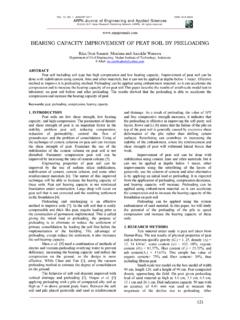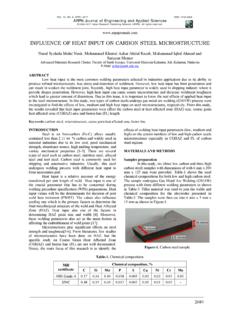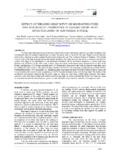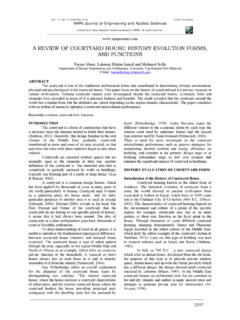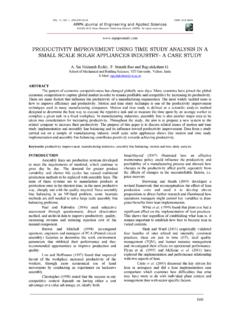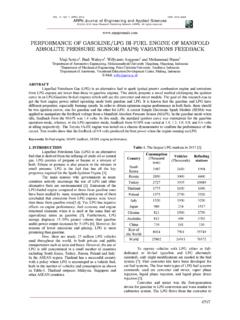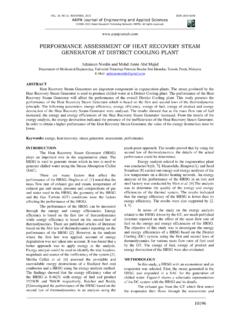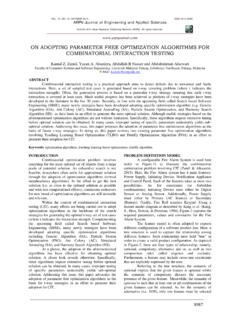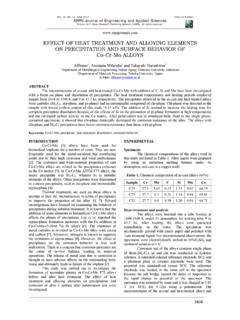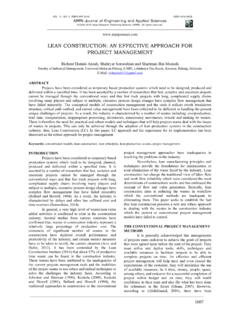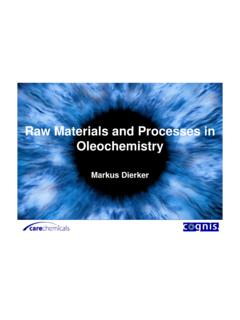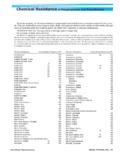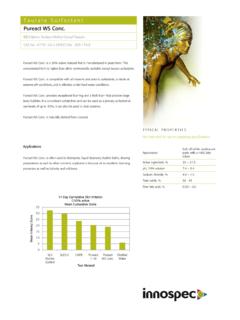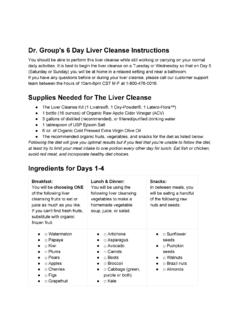Transcription of STABILITY OF VIRGIN COCONUT OIL EMULSION WITH …
1 VOL. 11, NO. 8, APRIL 2016 ISSN 1819-6608. ARPN Journal of Engineering and Applied Sciences 2006-2016 Asian Research Publishing Network (ARPN). All rights reserved. STABILITY OF VIRGIN COCONUT OIL EMULSION with MIXED. EMULSIFIERS TWEEN 80 AND SPAN 80. Lastri Wiyani1, Andi Aladin1, Setyawati Yani1 and Rahmawati2. 1 Department of Chemical Engineering, Muslim University of Indonesia, Jl Urip Sumoharjo, Makassar Indonesia 2 Faculty of Pharmacy, Muslim University of Indonesia, Jl Urip Sumoharjo, Makassar Indonesia E-Mail: ABSTRACT. VIRGIN COCONUT oil EMULSION (VCOE) is an alternative VCO product which has a reduced amount of oily taste when the VCO is consumed directly. This study was aimed to obtain the formulation of VCOE and determine the physical and chemical properties and also STABILITY of EMULSION with the addition of mixed emulsifiers Tween 80 and Span 80.
2 (T80S80). Emulsions were formulated using mixed emulsifiers with the mass ratio of T80 to S80 of 100:0; 80:20; 60:40;. 40:60; 20:80 and 0:100, respectively. The best ratio of the emulsifier was used to determine the STABILITY of VCO and water mixtures with the diversity ratio of VCO to water were 90:10, 80:20, 70:30, 60:40, 50:50, 40:60, 30:70, 20:80 and 10:90, respectively; the concentrations of emulsifier used were 1, and VCOE was successfully formulated in the mixture of VCO-water ratio of 80:20. The VCOE products have high viscosities in each concentration of emulsifier and remained stable in room temperature. The contents of the peroxide number were to meq/kg sample and free fatty acid were to , which indicated that the emulsions were not rancid. Keywords: VCO EMULSION , emulsifier, STABILITY . INTRODUCTION STABILITY is an increase in droplet mean diameter of the VIRGIN COCONUT oil (VCO) is produced from fresh EMULSION , and the growth rate of the droplets can reveal the and mature coconuts by mechanical or natural techniques mechanism responsible [11].
3 The EMULSION STABILITY is without heating, so the nature of the oil is unchanged [1]. highly influenced by the specific gravity, droplet size and VCO has a higher phenolic content and antioxidant activity distribution, and the rheological characteristics. The compared to copra-derived COCONUT oil. Based on the addition of hydrocolloids to the aqueous phase can yield benefits of this value-added functional oil, the development specific rheological properties to achieve EMULSION of a VCO-based EMULSION product as a novel nutritional STABILITY . Some hydrocolloids act as a surface active gums, food supplement will indirectly increase the consumption having the ability to form a film around the oil droplets. As of VCO because most consumers dislike the oily taste of a result of static stabilisation, hydrocolloids aid in delaying pure VCO [2], [3]. One alternative for reducing the oily this coalescence and prevent EMULSION breakdown.
4 Taste is by formulating VCO in the EMULSION . The Moreover, some hydrocolloids are known to stabilize the transformation of VCO into a more palatable and stable emulsions by enhancing the viscosity of the aqueous phase VCO-based EMULSION product will also be an advantage for [3]. the VCO-producing industry [3]. Forming a stable EMULSION for a period of time to Thermodynamically, an EMULSION is an unstable increase shelf-life is one of the main challenges of food system. However, the EMULSION is the basis of many food product formulation. This can be achieved through the products. The EMULSION 's STABILITY is very important for addition of emulsifiers and stabilizer. Emulsifiers are ensuring its quality. This property is a challenge for many surface-active molecules which could lower the surface industries. The STABILITY factor is sometimes affected by the tension and prevent the droplet flocculation by absorption physicochemical characteristics of the gums added during on the droplet surfaces [10].
5 Research on emulsions with the aqueous phase [3], [4]. various emulsifiers have been reported. For example, The homogeneity of an EMULSION is affected by Permadi [6] investigated the use of Tween 80 and lecithin mixing speed and time. For example, Rita [5] using the as emulsifier in the STABILITY of fish oil EMULSION , gum mixing speed of 6000 rpm, 8000 rpm and 10000 rpm for arabic [12] lecithin, xanthan gum [13], glycerin fatty ester 1, 3, 4 minutes to produce homogeneous emulsions. Other acid [14], gum Odina [15], roselle extract [16], Tween 80. researchers reported using 10,000 rpm for 15 minutes [6], and sucrose fatty acid ester (P-type S 1570 and 1570) [5]. 10000 rpm for 5 minutes [7], 13,500 rpm for 30 seconds According to Ansel [17], the surfactant, also [8] and 11,500 rpm for 5 minutes [9] to achieve called emulsifier plays an important role in EMULSION homogeneity.
6 Formation by reducing the interfacial tension. They also EMULSION STABILITY refers to the ability of an reported that the surfactants mixture increased the EMULSION to resist changes in its properties over time: the solubility of the bioactive compound in the EMULSION . more stable the EMULSION , the more slowly its properties Moreover, the chemical structure of surfactant must be change [10]. The perceived quality of EMULSION based considered because the chain length compatibility of a food products are strongly influenced by their STABILITY , surfactant and oil is an important factor in the formation of rheology and appearance [4]. A main indicator of loss of EMULSION . The combination of high and low Hydrophilic 5198. VOL. 11, NO. 8, APRIL 2016 ISSN 1819-6608. ARPN Journal of Engineering and Applied Sciences 2006-2016 Asian Research Publishing Network (ARPN).
7 All rights reserved. Lipophilic Balance (HLB) values of surfactants provides as an indicator. Peroxide number was expressed in meq /. the necessary conditions for the formation of a stable kg sample [19]. water-oil EMULSION [17], [18]. The objective of the present study was to Free fatty acid test determine the effect of mixed Tween 80 and Span 80 30 grams of sample was weighed and put into an (T80S80) on the physical, chemical properties and STABILITY Erlenmeyer flask, then 50 ml of hot neutral alcohol and 2. of VCO EMULSION . The effects of VCO-water ratio and the ml of phenolphthalein (pp) were added. Then, it titrated concentration of emulsifier to the STABILITY of VCO with N NaOH which had been standardized until pink EMULSION were also studied. It is expected that by color and not disappeared for 30 seconds. Free fatty acid understanding those effects more stable VCO emulsions content was expressed as % FFA [20].
8 Could be produced and the knowledge could be applied in VCO home industries. Viscosity test The prepared EMULSION was measured using METHODOLOGY Brookfield viscometer DV-I Prime. Rotation of spindle on the viscometer could be set according to the viscosity of Materials and equipment the sample. Viscosity values would be read directly on the VIRGIN COCONUT oil (VCO) was obtained from a device (cP). local VCO producer (CV. Avcol, Makassar, Indonesia). Low HLB surfactant, sorbitan monooleate (Span 80, HLB EMULSION STABILITY test = , Sigma) and high HLB surfactant, polyoxyethylene Approximately 60 ml of sample was put into a sorbitan monooleate (Tween 80, HLB = , Merck) were bottle and stored at 5 0C for 12 hours, then stored at a purchased from local chemical supplier. temperature of 35 0C for 12 hours. This cycle was repeated The emulsions were prepared by Ultra Turrax for 10 cycles (5 cycles of temperature of 5 0C and 5 cycles homogenizer (specification: a minimum speed 3600 rpm of 35 0C).)
9 The STABILITY of VCOE was determine as and maximum 24000 rpm, particle size 1-10 micron). The follows: viscosity were measured using a Brookfield viscometer % STABILITY = (height of stable EMULSION /height of initial model DV-I Prime. EMULSION ) x 100 [21]. Preparation of mixed emulsifiers RESULTS AND DISCUSSION. Mixtures of emulsifier T80S80 were prepared at the following ratios of T80:S80, namely 100: 0, 80:20, Characteristics of VCOE with mixed emulsifiers 60:40, 40:60, 20:80, and 0: 100, respectively. The mixture T80S80. were stirred by using a magnetic stirrer to obtain a Table-1 shows the characteristics of mixed homogeneous mixture emulsifiers T80S80. The peroxide number ranged from to meq / kg sample. It shows that the peroxide Preparation of VCO EMULSION number in the obtained VCOE met the Asia Pacific The VCOE was prepared by using VCO-water COCONUT Community (APCC) standard for VCO which (ratio 70:30) and 1% mixed emulsifier T80S80 (ratio 100: stated that the peroxide number of VCO has to be under 3.
10 0, 80:20, 60:40, 40:60, 20:80, 0: 100) using Ultra Turrax meq / kg sample. homogenizer operating at 15,000 rpm for 4 minutes. The best combination of the mixtures would be used for the Table-1. Characteristics of VCOE with mixed emulsifiers. next experimentation. This procedure was repeated with the ratio of VCO to water of 90;10, 80:20, 70:30, 60:40, 50:50, 40:60, 30:70, 20:80, 10:90, respectively, using the the best of mixed emulsifier from previous step. The concentrations of emulsifier were 1%, and Peroxide number test Five grams of samples were put in a 300 mL. Erlenmeyer flask. 10 ml of chloroform and 15 ml of glacial acetic acid was added into the Erlenmeyer and then shaken to mix it. One ml of saturated KI was added and the Erlenmeyer was immediately closed while shaken roughly for 5 minutes in the dark at a temperature of 15-25 0C. Table-1 also shows the contents of free fatty acids Then, 75 ml of distilled water were added and shaken in the emulsions, they ranged between %.
